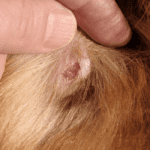- Nom Nom Dog Food Subscription Review - November 7, 2023
- 7 Best Dog Bed Ideas For Great Dane (DIY Options) - July 16, 2022
- Top 5 Rated Best Non-Prescription Diabetic Dog Food - July 15, 2022
As soon as the weather turns warm, the mosquitoes come out in droves, and they can pose a serious health risk for your dog. Mosquitoes transmit heartworm disease, a quite horrendous and potentially fatal infection that damages the dog’s internal organs.You can protect your pet to an extent by keeping it indoors at dawn and dusk, the times when mosquitoes are most active, and by boosting its immune system with a healthy diet that includes vegetables and fruits, but it is impossible to shield your dog entirely in this manner and only one mosquito bite can transmit the disease. The subsequent treatment can be long, fairly expensive, and distressing for your pet, and doesn’t guarantee a complete cure; the dog can suffer permanent organ damage and, in severe cases, may succumb to the disease. Many pet parents prefer to avoid this trauma by putting their dogs on monthly preventive medications and by getting annual veterinary checkups for early detection of any infection.
Monthly preventive medications and annual checkups can be costly, so you might want to consider getting pet insurance for heartworm treatment. Many insurance companies offer wellness plans that cover preventive treatment for heartworm and will pay 90% of your vet bills. This can relieve any financial worries you might have and allow your pet access to the best treatment necessary.You should know though that pet insurance plans do not cover preexisting conditions, so, if your dog already has heartworm, the insurance company will decline to give you insurance cover for the condition. It might be best to get pet insurance before your dog develops heartworm.
What is Heartworm Disease?

In 1847, the Western Journal of Medicine and Surgery printed ‘Worms found in the Heart and Bloodvessels of a Dog; Symptoms of Hydrophobia’ by Alabama veterinarian, Dr. T. C. Osborne, a first ever published account about Dirofilaria immitis or heartworm disease in a dog.
Dirofilaria Immitis are parasitic white worms that cause heartworm disease; the disease gets its name from their tendency to target the heart and other internal organs of their host.
The disease is widespread in the Mississippi Valley region and in the Southeastern part of the United States, and in many other parts of the world. Anywhere you have a high density of mosquitoes, you can expect to find this infection in the local dog population. The disease doesn’t transfer from canines to humans, but if you are bitten by a carrier mosquito you can get the human version.
How Does a Dog Get Infected With Heartworm Disease?
When a mosquito bites a dog infected with Dirofilaria immitis worms, it picks up microscopic larvae or microfilariae and these incubate within it for about two weeks. The infected mosquito cannot transmit the incubating microfilaria in this period. After undergoing three stages of development within the mosquito, the larvae migrate to the mosquito proboscis and the mosquito can now transfer them to the next dog it bites.
The mosquito deposits the larvae, contained in a drop of mosquito saliva, on the new host’s skin. The larvae then move into the body through the mosquito bite incision to burrow into the skin tissue. After incubating here for two weeks, they move to the chest and abdomen muscles for a further incubation of two to three months. The now young adult heartworms next migrate into the bloodstream and, after about six months, mature into male and female adults that can grow up to 12 to 14 inches in length. These adults live in the right ventricle of the heart and in the pulmonary artery, and they mate and produce microfilariae. The microfilariae, unless they are transmitted to another host, die off in about two years, but the adult worms can live for seven years inside the existing host, and subsequent mosquito bites will only increase the number of worms.
Unless treated, the heartworms will keep on multiplying till the infected dog harbors several hundred of these parasites. Such an infestation will affect and permanently damage the heart, lungs, kidneys, liver, and other organs, leading to organ failure and death.
Symptoms of Heartworm Disease
Symptoms of heartworm disease can be difficult to discern in the early stages, and all dogs do not show the same symptoms or the same sequence of symptoms. Your pet might appear perfectly normal at first. As the infection progresses though, the dog will develop a deep, persistent cough, sometimes bringing up blood. The dog will lose its appetite, suffer weight loss, become lethargic, and tire very easily.
As the worms clog up the heart and the lungs, your pet will have difficulty breathing and can develop fever and nose bleeds. Further on, the growing number of worms will impede the arterial blood flow and cause excessive fluid buildup in the dog’s abdomen, giving it a distended appearance. The dog will have fainting episodes and will suffer a cardiovascular collapse known as Caval Syndrome. At this late stage, the chances of the dog’s survival without surgical intervention are slim.
How Is Heartworm Treated and Do You Need to Know?

If your dog is less than 7 months of age, it is too young to harbor adult heartworms and putting it on preventive medication can generally clear off any microfilariae.
To detect the presence of heartworms in your older dog, the veterinarian will need to carry out a series of blood tests. There are different tests for detecting microfilariae and for detecting adult female heartworms; male heartworms are not detectable in any testing methods currently used. A direct blood smear test detects microfilariae in large concentrations, while the Difil test and Knott’s test can detect more minor infections. Antigen tests detect the adult female heartworms.
You should know that these tests can give false negative results for a variety of reasons –
- The female heartworms are too immature
- The number of female heartworms is too low for detection
- Only male heartworms are present, no females
- No mating and therefore no microfilariae
- The number of microfilariae is too low for detection
If the blood tests come out positive, the veterinarian may carry out a DNA-PCR test to make sure that the microfilariae are those of heartworm and not any other similar parasites. The veterinarian may then recommend a chest x-ray and a heart ultrasound to gauge the severity of the infection. This and your dog’s age, size, and medical history will determine the subsequent treatment plan.
Treatment generally extends over a period of several months and can be very tough on your dog. You will need to entirely curtail your dog’s physical activities for the treatment duration, and make sure the animal is well-rested and kept as quiet as possible. Exercise or excitement accelerates the heart rate and the dog’s damaged organ may not be able to withstand the stress, leading to heart failure. There are also side effects from the dead heartworms
At the beginning of the heartworm treatment, your veterinarian will prescribe Ivermectin-based tablets, syrup, or injection to kill off the microfilariae. It is necessary to get rid of these larvae first to halt the further spread of the infection. Your dog may need to take the medication for one to three months to get rid of all the microfilariae.
Next, the veterinarian will prescribe three doses of Melarsomine dihydrochloride-based injections to target and kill the young adult worms and the adult worms in the pulmonary arteries and heart. The Melarsomine injections are given in the lower back muscles and can be very painful. Your dog may require pain medication and a topical application to treat the injection sores.
The first Melarsomine dose is followed a month later by the second dose and the third is given 24 hours after the second one. The medication is spaced out in this manner to avoid killing all the worms at once, which can be very dangerous; the dead worms can clog up the arteries and cause circulatory shock and organ failure. It may be necessary to hospitalize the dog in such an event.
How Much Does Heartworm Treatment Cost?
According to the American Animal Hospital Association, you might need to spend between $5 to $15 for preventive medications on a monthly basis, and if you dog has already contracted the heartworm infection, the costs might range between $400 to $1000 for the veterinarian visits, various blood tests, chest x-ray, heart ultrasound, injections, and overnight hospital stays. Costs are more for larger dogs as compared to smaller ones. In very severe cases, where surgical intervention is necessary to extract the heartworms, the treatment cost might run up to $4000.
Plans Coverage Comparison of Heartworm Treatment
Given the high costs of heartworm treatment, it is common for people in the United States and many other countries to opt for pet insurance. Numerous pet insurance companies offer a plethora of plans and it can be confusing to pick the right one for you and your pet. Since we are talking about heartworm treatment here, the first step would be to look for a plan that covers this.
Heartworm preventive care is included in routine care plans that most pet health insurance companies offer.You may either be able to buy routine care plans separately or may need to add them to a regular illness and accident pet insurance plan. Some insurance companies do not offer a routine care or wellness plan at all, preferring to offer insurance for unexpected illnesses and accidents rather than preventive care that can be planned and budgeted for.
You will also need to check if the regular insurance covers or does not cover heartworm treatment in the event that your dog contracts the disease. Since this is something that could have been avoided with preventive care, many insurance companies exclude it from their insurance plan. As already mentioned above, none of the insurance companies will pay for the treatment of a heartworm condition preexisting before you buy your plan.
Other things to consider before selecting a pet insurance company:
- Does it provide a stellar customer service?
- Is it easy to submit claims and are they reimbursed timely?
- How much do you have to pay on a monthly basis and what will it cost you annually? How much will you be reimbursed?
Compare the plans offered by different companies and find the one that meets your budget.
Should You Get Pet Insurance for Heartworm Treatment?
You need to understand how pet insurance works. In the case of routine care plans, you pay a set monthly fee to the pet insurance company. When you take your pet for routine care at any veterinary clinic of your choice, the company will either reimburse the veterinarian directly or reimburse you according to what your insurance policy specifies. To be reimbursed, you will need to file a claim form and include an invoice and a copy of the medical records of your visit. Once the company has received and processed your filed claim, you will receive your reimbursement, usually within a month.
You may either be able to buy routine care plans separately or may need to add them to a regular illness and accident pet insurance plan. This depends on the insurance company, and some companies do not offer a routine care or wellness plan at all. So be sure to check.
Getting routine care insurance sounds perfectly reasonable if your annual routine care costs are in the $300 to $600 range, or, in certain situations, could exceed these. The insurance, in this instance, can relieve you of financial stress and also get your dog the treatment it needs. This is really the point of getting pet insurance.
On the other hand, if you have a healthy pet and your routine care costs only around $100, which you are able to afford without any trouble, it might make more sense to put aside additional money for emergencies in a savings account for your pet rather than paying it to an insurance company.
It really depends on your specific situation.
Continue reading:
Does Pet Insurance Cover Vaccinations? (Costs)




